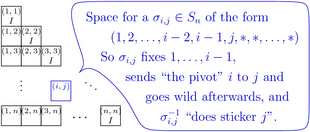10-1100/Homework Assignment 1: Difference between revisions
No edit summary |
No edit summary |
||
| Line 2: | Line 2: | ||
{{In Preparation}} |
{{In Preparation}} |
||
This assignment is due at class time on Tuesday, October 12, 2010. |
|||
===Part I=== |
|||
Web search "Rubik's Cube Variants" (look at images), or look at [http://en.wikipedia.org/wiki/Combination_puzzle Wikipedia: Combination Puzzle] or [http://www.twistypuzzles.com/ TwistyPuzzles.com], or search elsewhere or go to a toy shop, pick your favourite "permutation group puzzle" (other than the Rubik Cube, of course), and figure out how many configurations it has. For your solution to count the number of configurations must be more than you can count, and your solution must include a clear picture or diagram of the object being studied, its labeling by integers, the list of generating permutations for it, and a printout of the program you used along with screen shot of its output (or an input/output log). It is ok to use the program presented in class (Mathematica is available on a departmental server; look for it!) but better to write your own. You can submit your solution either as a wiki page on this server (best option), or as a URL elsewhere (second best), or as a single file in any reasonable format, or on paper. |
Web search "Rubik's Cube Variants" (look at images), or look at [http://en.wikipedia.org/wiki/Combination_puzzle Wikipedia: Combination Puzzle] or [http://www.twistypuzzles.com/ TwistyPuzzles.com], or search elsewhere or go to a toy shop, pick your favourite "permutation group puzzle" (other than the Rubik Cube, of course), and figure out how many configurations it has. For your solution to count the number of configurations must be more than you can count, and your solution must include a clear picture or diagram of the object being studied, its labeling by integers, the list of generating permutations for it, and a printout of the program you used along with screen shot of its output (or an input/output log). It is ok to use the program presented in class (Mathematica is available on a departmental server; look for it!) but better to write your own. You can submit your solution either as a wiki page on this server (best option), or as a URL elsewhere (second best), or as a single file in any reasonable format, or on paper. |
||
===Part II=== |
|||
Solve the following questions. |
|||
# (Selick) If <math>g</math> is an element of a group <math>G</math>, the ''order'' <math>|g|</math> of <math>g</math> is the least positive number n for which <math>g^n=1</math> (may be <math>\infty</math>). If <math>x,y\in G</math>, prove that <math>|xy|=|yx|</math>. |
# (Selick) If <math>g</math> is an element of a group <math>G</math>, the ''order'' <math>|g|</math> of <math>g</math> is the least positive number n for which <math>g^n=1</math> (may be <math>\infty</math>). If <math>x,y\in G</math>, prove that <math>|xy|=|yx|</math>. |
||
# (Selick) Let <math>G</math> be a group. Show that the function <math>\phi:G\to G</math> given by <math>\phi(g)=g^2</math> is a morphism of groups if and only if <math>G</math> is Abelian. |
# (Selick) Let <math>G</math> be a group. Show that the function <math>\phi:G\to G</math> given by <math>\phi(g)=g^2</math> is a morphism of groups if and only if <math>G</math> is Abelian. |
||
Revision as of 08:17, 29 September 2010
| |||||||||||||||||||||||||||||||||||||||||||||||||||||||||
The information below is preliminary and cannot be trusted! (v)
This assignment is due at class time on Tuesday, October 12, 2010.
Part I
Web search "Rubik's Cube Variants" (look at images), or look at Wikipedia: Combination Puzzle or TwistyPuzzles.com, or search elsewhere or go to a toy shop, pick your favourite "permutation group puzzle" (other than the Rubik Cube, of course), and figure out how many configurations it has. For your solution to count the number of configurations must be more than you can count, and your solution must include a clear picture or diagram of the object being studied, its labeling by integers, the list of generating permutations for it, and a printout of the program you used along with screen shot of its output (or an input/output log). It is ok to use the program presented in class (Mathematica is available on a departmental server; look for it!) but better to write your own. You can submit your solution either as a wiki page on this server (best option), or as a URL elsewhere (second best), or as a single file in any reasonable format, or on paper.
Part II
Solve the following questions.
- (Selick) If is an element of a group , the order of is the least positive number n for which (may be ). If , prove that .
- (Selick) Let be a group. Show that the function given by is a morphism of groups if and only if is Abelian.
- (Lang, pp 75) Let be a group. For , the commutator of and is . Let be the subgroup of generated by all commutators of elements of . Show that is normal in , that is Abelian, and that any morphism from into an Abelian group factors through .
- (Lang, pp 75) Let be a group. An automorphism of is an invertible group morphism . An inner automorphism is an automorphism of given by conjugation by some specific element of , so . Prove that the inner automorphisms of form a normal subgroup of the group of all automorphisms of .












![{\displaystyle [a,b]}](https://wikimedia.org/api/rest_v1/media/math/render/svg/9c4b788fc5c637e26ee98b45f89a5c08c85f7935)


![{\displaystyle [a,b]=aba^{-1}b^{-1}}](https://wikimedia.org/api/rest_v1/media/math/render/svg/2fab1df643e968bbe6c84336d0a380d5133c1b0f)



